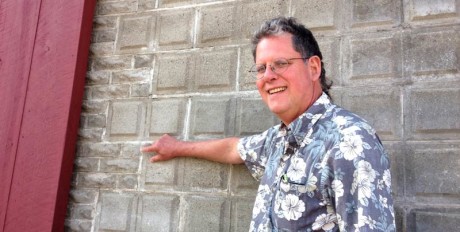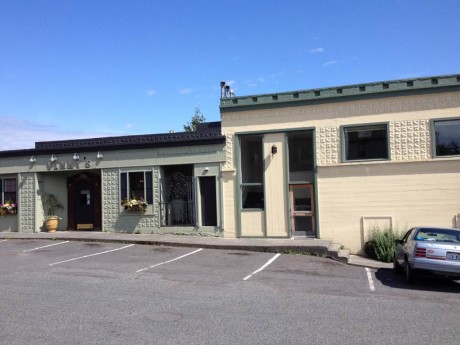Boyd Talks About Bricks
Posted June 18, 2014 at 5:52 am by Tim Dustrude

Boyd Pratt with cement blocks of two different patterns on the old Friday Harbor Brick & Tile Co., today’s Brickworks – Louise Dustrude photo
Local historian Boyd Pratt leads show-and-tell tours from time to time, and one of his recent tours helped participants understand something about the physical appearance of Friday Harbor.
A disastrous fire in the downtown area on April 4-5 of 1925 destroyed a grocery store and dry goods store (where the deli end of Kings Market is now) and led within two months to a town ordinance requiring new buildings in the core to be built of fireproof materials: brick, stone, or concrete.
The Friday Harbor Brick & Tile Co. had just opened in 1921 and was able to supply all of these materials locally.
The first downtown construction under the new ordinance was Friday Harbor Light & Power Co. (now Daisy Bloom), built later in 1925 of concrete block.
It was followed by the post office (now Griffin Bay Books) in 1927; the drug store in 1929; garages at Argyle and Spring (now the Little Store) and at Nichols and Sunshine Alley (now Girlfriends) and the house that became the public restrooms, all before 1930; and the town hall, built with WPA funds in 1936 — all except the (brick) drug store built of concrete block.
Already constructed long before the fire were the courthouse in 1906 and San Juan County Bank (now Coldwell Banker) in 1907, both of brick; the old part of Kings Market in 1909-10 of concrete block; and Schuman Motors (now Vinny’s, the Friday Harbor Film Festival, and The Toy Box) of concrete block in 1916.
The Brick & Tile Co. itself — now known as the Brickworks — was built in 1921 of concrete blocks constructed on the site to showcase its own products.
In 1974 the ordinance was superseded by the Uniform Building, Mechanical, Fire, and Plumbing codes, which also required fireproof construction.
The newspaper account of the 1925 fire called it “spectacular,” and added: “That the entire business section of the town was not destroyed is due only to the fact that there was absolutely no wind, the effectiveness of the city water system, and the hard work of the volunteer fire fighters.”
Memories of the fire, and concern for the future, also led to the extension of Sunshine Alley behind several Spring Street businesses, including the bank, to provide access for fire trucks if needed. Sunshine Alley had been just a short street in front of the Brick & Tile Co. and then an angled continuation to Spring Street between the present-day Palace Theater and the former Sam’s Shoe Store.
Boyd told the group, “It remains a mystery as to how Sunshine Alley got its name.”
You can support the San Juan Update by doing business with our loyal advertisers, and by making a one-time contribution or a recurring donation.
Categories: Around Here











No comments yet. Be the first!
By submitting a comment you grant the San Juan Update a perpetual license to reproduce your words and name/web site in attribution. Inappropriate, irrelevant and contentious comments may not be published at an admin's discretion. Your email is used for verification purposes only, it will never be shared.